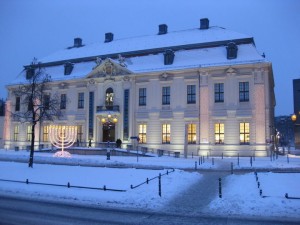
The very idea of a Jewish Museum in Berlin speaks for the change in the global political and social scenario in the past fifty years. A visit to the Jewish Museum Berlin by ECLA students was arranged by Ryan Plumley, primarily for the “What is History?” class. The Museum visit was one of the most interesting museum visits for many of us, especially for those who had only read about the Holocaust in books or had seen movies based on it.
The Jewish Museum starts with an airport-style security check, which instills 21st-century anxieties of terrorism, that seem to set a tone fitting for a place that meditates on the terrorism that besieged countless communities during the Second World War.
Each and every person is asked to leave all belongings, even eatables, at the checkpoint, and in some slight way this incidentally mimics the anxiety instilled in many Jewish communities across Europe. The conflict, although it is over on the surface, can still be felt through the danger that the community itself feels. Or many people would simply say that old fears die hard.
The most amazing thing about the Jewish museum was the architecture of the museum. The museum was designed without any objects and only the architecture itself was to convey and narrate the history of the German Jews. The New York architect Daniel Libeskind designed the exterior, the lower level, which is interestingly the entrance to the first exhibition of the museum, as well as the ground floor. The basement had two different planes, one of the planes leading towards the isle of the Holocaust and ending in the tower of the Holocaust.
One of the last planes opens up a new avenue in History, the present relationship between Germans and Jews. This plane opens in the Garden of Memory where the plants grow around the inkling memorial. One can now see people taking snapshots, loudly chatting and some trying to impress their dates with their knowledge of history, walking through the memorial and the long shoots of plants. Here one can see a new door that has opened in the relationship between two communities, a relationship of love and mistrust at the same time.
The floors above were very intricately divided in several different parts, one specifically designed for the exhibitions and the other to cover the history of the Jews in Europe, from Middle Ages to the present. One of the most harrowing parts of the museum was the long-term temporary exhibit Shalekhet (Fallen Leaves) put forth by Israeli artist Menashe Kadishman. In a dark, dingy corner of the museum, an angular deep space had been left vacant and now has a haunting carpet of rusted, round steel faces.
The whole place echoed of clinking and clanking sounds as people gingerly walked on top of the thousands of faces. The very feeling of placing one’s feet on these faces- the feeling that hundreds and thousands and millions of people died and their faces and there identities remain unknown- sends a chill down one’s spine. The piece is dedicated not only to the victims of the Holocaust, but all innocent victims of war.
Another part of the museum that actually takes the visitor back in history is the Holocaust tower. It is hard to imagine though what it would be like in real life, but the Holocaust tower is still a good reminder of one of the darkest incidents in human history.
The tower opens in the aisle of the Holocaust where pictures and different memory icons are visible and displayed. At the end of the tower it becomes absolutely dark and then a huge black door allows you to enter the tower. One feels the darkness and the walls closing in, through which you can still feel the voices of the dying people. The tower is dark and yet at the same time a ray of light is allowed to enter from one part of the wall, intuitively suggesting that perhaps “there is light at the end of every tunnel.”,
